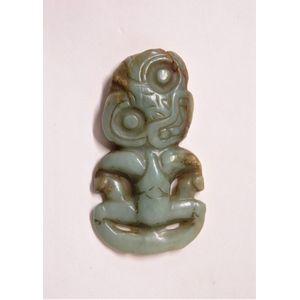Lambert Dunedin Salt Glazed Pineapple Chimney Pot
You must be a subscriber, and be logged in to view price and dealer details.
Subscribe Now to view actual auction price for this item
When you subscribe, you have the option of setting the currency in which to display prices to $Au, $US, $NZ or Stg.
- Salt Glazed - Salt glazing involves throwing salt into the kiln when it is at its highest temperature, usually around 2,300 to 2,400 degrees Fahrenheit (1,260 to 1,320 degrees Celsius). The salt vaporizes and forms a glaze on the surface of the pottery, creating a range of effects depending on how the salt is applied and the firing conditions. This glazing method was first developed in Germany in the 15th century and quickly became popular throughout Europe and North America. It was particularly popular for making stoneware pottery, such as jugs, crocks, and other utilitarian objects.
Salt glazes can produce a range of colors, including gray, brown, blue, and even pink or purple in some cases. The texture of the glaze is typically rough and pebbled, with a matte or satin finish. The process of salt glazing can be unpredictable, with variations in temperature and salt application leading to subtle variations in the finished product.
Salt glazing is still used by potters and ceramic artists although it is less common than it was in the past. - Acanthus - A stylized leaf motif, one of the primary decorative elements of classical Greek and Roman architecture, derived from the genus of flowering plants in the family Acanthaceae, native to tropical and subtropical regions of the Mediterranean area. It is a common element in classical Greek and Roman design, and is often seen in Corinthian and Composite order columns and used as a decorative element in English, European and Australian furniture, particularly on the curve of a leg, and as decoration for a corbel.
- Pineapple - The pineapple, named because of its resemblance to a pine cone, was an exotic and scarce fruit in the 18th century. It became a popular decorative motif on furniture, silver ceramics, glass and clocks during this time.
This item has been included into following indexes:
Visually similar items

A white sea eagle Perched on a Rocky Outcrop, hanging scroll, signed Jin Kun with red seal mark, dated 1987, porcelain scroll ends, mounted on silk, 178 x 70 cm

French Dinky no. 33C Glazier's van Miroitier Simca 'Cargo', in original box (VG - E box P - F)

Two English etched glasses mid 18th century including a small wine glass and a gin glass, the wine glass 10.5 cm high

An uncommon pre-European Maori carved inunga pounamu hei tiki, good proportions and traditional form, chin to the left, hands to thighs, three tapered hourglass drilled and concealed suspension holes to the back top of head, one broken through, natural dar
